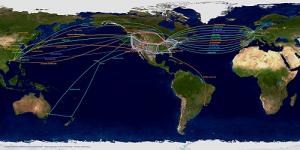UH awarded $4 million for international research networking
5-year project focuses on Asia-Pacific interconnectivity
University of HawaiʻiContact:
Posted: Aug 4, 2010
HONOLULU – The University of Hawaiʻi, in partnership with the Corporation for Educational Network Initiatives in California (CENIC) and the Pacific Northwest Gigapop (PNWGP), has received a $4 million 5-year award from the National Science Foundation (NSF) to advance international research networking in the Asia-Pacific region.
The award from the NSF International Research Network Connections (IRNC) program is called TransLight Pacific Wave and will help support the two 10-billion-bit-per-second research network connections that connect Australia to Hawaiʻi to the West Coast of the U.S. as well as support additional international network connections at the Pacific Wave network exchange in California and Washington.
The two high-speed circuits that connect Hawaiʻi are provided by Australia's Academic and Research Network (AARNet) solely for research and education under the auspices of the SX TransPORT project sponsored by the Southern Cross Cable Network. One circuit runs from Australia to Oahu to Pacific Wave in Seattle, and the other from Australia to the Big Island of Hawaiʻi to Pacific Wave in Los Angeles. This enables global connectivity for the Mauna Kea Observatories and the 13 telescopes there, which are operated by astronomers from 11 countries.
Pacific Wave is an innovative distributed network exchange developed and operated by CENIC and PNWGP that provides interconnectivity for domestic and international research and education networks on the West Coast of the U.S. Pacific Wave interconnects Internet2, National LambdaRail and U.S. governmental agency networks as well as national research and education networks from Canada, Mexico, Japan, Korea, China, Taiwan, New Zealand, Thailand, Singapore and more.
"The University of Hawaiʻi is honored to be selected to build on our collaborative work over the past years with CENIC, PNWGP, AARNet and our many other partners," said David Lassner, principal investigator for the award and UH vice president for information technology & chief information officer. "It is now more than 20 years since Torben Nielsen of our faculty collaborated with AARNet to establish Australia's first international Internet connection, at 56-thousand-bits-per-second. Today's links provide more than 350,000 times greater connectivity to support advanced cyberinfrastructure-enabled research and education."
The TransLight Pacific Wave project will also collaborate with other NSF IRNC awardees to ensure seamless global connectivity with international research and education networks in Europe, Latin America and other parts of the world. It also hopes to extend global research and education network connectivity to the Pacific Islands as infrastructure and resources permit.

